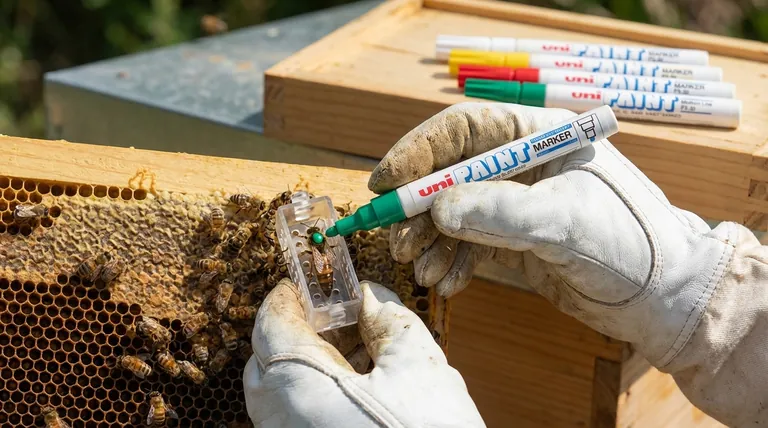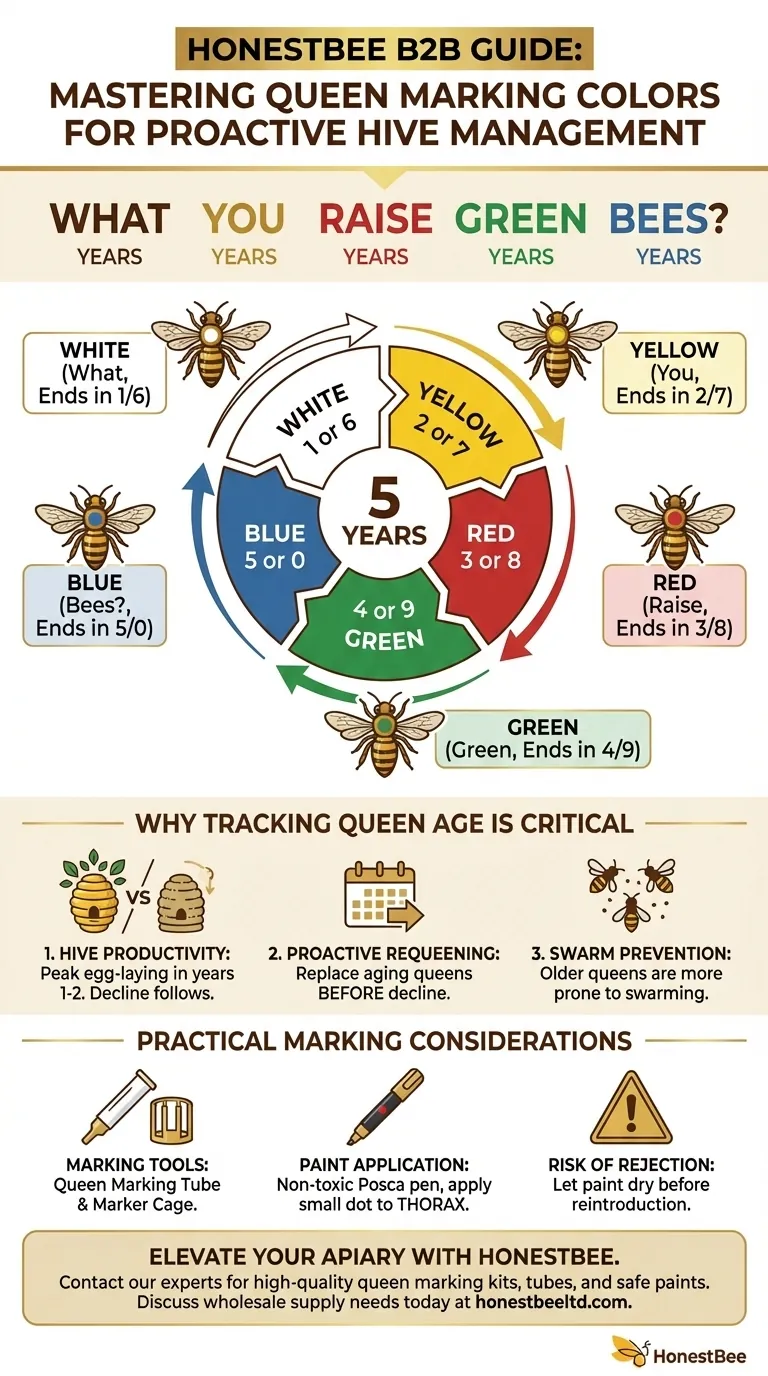To remember the international queen marking colors, the most effective method is the mnemonic "What You Raise Green Bees?". This phrase directly corresponds to the five-year color cycle: White, Yellow, Red, Green, and Blue. This system is the global standard for quickly identifying the age of a queen bee during hive inspections.
Remembering the color sequence is not just about memorization; it's a foundational skill for proactive hive management. The system connects each color to the last digit of a given year, allowing any beekeeper to instantly assess a queen's age and make critical decisions about the colony's future health and productivity.

Why Tracking Queen Age is Critical
A honey bee colony's success is almost entirely dependent on the vitality of its queen. Knowing her age is one of the most important data points you can have.
The Impact on Hive Productivity
A queen's egg-laying ability peaks in her first and second years. After that, her laying rate and the viability of her pheromones typically decline, leading to a weaker, less productive colony.
Proactive Requeening
Identifying an aging queen allows you to replace her before the hive's population dwindles or she fails completely. This proactive approach prevents a sharp decline in honey production and hive strength.
Swarm Prevention
Colonies with older queens are often more inclined to swarm. Knowing a queen is entering her third season helps you anticipate and manage this behavior more effectively.
How the Color System Works
The system is elegant in its simplicity. It's a repeating five-year cycle that corresponds to the final digit of the year the queen was born or introduced to the hive.
The 5-Year Cycle
Since a queen bee's productive lifespan is rarely more than four or five years, a five-color cycle is all that's needed. The pattern repeats every five years.
Tying Colors to Years
The sequence "What You Raise Green Bees?" (White, Yellow, Red, Green, Blue) maps directly to years ending in a specific digit:
- Years ending in 1 or 6 are marked White.
- Years ending in 2 or 7 are marked Yellow.
- Years ending in 3 or 8 are marked Red.
- Years ending in 4 or 9 are marked Green.
- Years ending in 5 or 0 are marked Blue.
Using the Mnemonic in Practice
To find the color for the year 2024, you look at the last digit: 4. You then recite the mnemonic, counting on your fingers: 1-White, 2-Yellow, 3-Red, 4-Green. Therefore, the color for 2024 is Green.
Practical Considerations for Marking
Simply knowing the color is the first step. The physical act of marking requires care and the right tools to ensure the queen's safety.
Choosing Your Marking Tool
The two most common tools are a queen marking tube and a queen marker cage. The tube secures the queen in a clear cylinder with a soft plunger, offering excellent control. The cage is a small grate that you gently press over the queen on the comb, which is often faster but requires a steady hand.
Paint Application
Specialized, non-toxic paint pens (like Posca pens) are the standard. They are quick-drying and safe for the bees. Apply a small, neat dot to the center of the queen's thorax (the middle section of her body), being careful to avoid her head, wings, and abdomen.
The Risk of Rejection
While rare, a colony can sometimes reject a newly marked queen, especially if the paint odor is too strong. Allowing the paint to dry completely for a minute before reintroducing her to the hive minimizes this risk.
Applying This to Your Apiary
Use this system to move from reactive fixes to strategic hive management.
- If your primary focus is learning: Practice reciting the mnemonic and matching it to the last digit of the current and upcoming years until it becomes automatic.
- If your primary focus is hive health: Mark all your queens and use their color as a primary data point during every inspection to guide your requeening strategy.
- If your primary focus is purchasing bees: When buying a nuc or a mated queen, always check that her marked color corresponds to the age claimed by the supplier.
This simple color code is your key to proactive, data-driven beekeeping.
Summary Table:
| Year Ends In | Queen Marking Color | Mnemonic Word |
|---|---|---|
| 1 or 6 | White | What |
| 2 or 7 | Yellow | You |
| 3 or 8 | Red | Raise |
| 4 or 9 | Green | Green |
| 5 or 0 | Blue | Bees? |
Ready to implement this essential skill? Proactive hive management starts with the right tools. HONESTBEE supplies commercial apiaries and beekeeping equipment distributors with high-quality, durable queen marking kits, tubes, and non-toxic paints designed for efficiency and bee safety. Ensure your operation has the professional-grade equipment it needs to succeed. Contact our wholesale experts today to discuss your supply needs and elevate your beekeeping practice.
Visual Guide

Related Products
- Queen Bee Marking Pen UNI Medium Point for Queen and Bee Marking
- Queen Bee Marking Pen POSCA Queen Marking Pens for Beekeeping Bee Markers
- Nicot Queen Rearing Kit for Beekeeping and Grafting in Nicot System
- Jenter Queen Rearing Kit Complete Set for Bee Breeding
- No Grafting Queen Rearing Kit: System for Royal Jelly Production and Queen Rearing
People Also Ask
- What are the advantages of using Uni-Posca markers for Queen marking? A Safe, Precise, and Efficient Solution
- What is the purpose of a queen marking pen in beekeeping? Essential for Efficient Hive Management
- What type of pen is used to mark a queen bee? A Guide to Safe, Effective Hive Management
- What is the process for priming a paint pen before marking a Queen bee? Ensure a Safe, Quick Marking Procedure
- What are the benefits of marking queen bees? Boost Hive Health & Management Efficiency


















